Nano-Mineralogy and Mineralization of the Polymetallic Nodules from the Interbasin of Seamounts, the Western Pacific Ocean
Abstract
:1. Introduction
2. Geological Setting
3. Samples and Analytical Methods
3.1. Sample Pretreatment and Microscopic Observation
3.2. XRD Analysis
3.3. Gas Adsorption Analyses of Porous Structures
3.4. FT-IR Spectral Analysis
3.5. TEM Analysis
4. Results
4.1. Microscopic Structure Characteristics
4.2. XRD
4.3. Infrared Spectrum Analysis
4.4. TEM and EDS
4.5. Nanoporous Structure
5. Discussion
5.1. Mineral Compositions and Depositional Environment
5.2. Nano-Mineralogy
5.2.1. Nano-Mineral Characteristics
5.2.2. Nano-Mineral Properties
Pore Structure
Specific Surface Area
Pore Size Distribution
5.3. Nano-Mineral Mineralization
6. Conclusions
- The Fe-Mn encrusts of the Fe-Mn nodules from the IBSWP grow in a certain pattern. The primary growth structures inside the Fe-Mn nodules mainly include laminated, stromatolithic, columnar, and mottled structures.
- The crystallinity of Mn-phase minerals in the Fe-Mn nodules from the IBSWP is low, primarily consisting of vernadite as well as 10 Å Mn-phase minerals and birnessite. Using FT-IR analysis, it was found that the 10 Å Mn-phase minerals in the sample were mainly todorokite and buserites, while the Fe-phase minerals were amorphous aqueous Fe-phase minerals (FeOOH). Other detrital minerals, such as phillipsite and quartz, were also detected with good crystallinity. The coexistence of vernadite and 10 Å Mn-phase minerals indicates that the nodules were precipitated in alternating hydrogenetic and diagenetic conditions.
- The Fe-Mn minerals found in the Fe-Mn nodules from the IBSWP all exist in the form of nanoscale minerals. The nanoscale Fe-Mn minerals contributethe great specific surface areas and unique pore structures to the Fe-Mn nodules, which are crucial factors in the selective enrichment of key metal ions in the nano Fe-Mn minerals.
Author Contributions
Funding
Data Availability Statement
Acknowledgments
Conflicts of Interest
References
- Hein, J.R.; Mizell, K.; Koschinsky, A.; Conrad, T.A. Deep-ocean mineral deposits as a source of critical metals for high- and green-technology applications: Comparison with land-based resources. Ore Geol. Rev. 2013, 51, 1–14. [Google Scholar] [CrossRef]
- Hein, J.R.; Koschinsky, A. Deep-ocean ferromanganese crusts and nodules. In Treatise on Geochemistry, 2nd ed.; Holland, H.D., Turekian, K.K., Eds.; Elsevier: Gainesville, FL, USA, 2014; Volume 13, pp. 273–291. [Google Scholar]
- Guan, Y.; Sun, X.; Ren, Y.; Jiang, X. Mineralogy, geochemistry and genesis of the polymetallic crusts and nodules from the South China Sea. Ore Geol. Rev. 2017, 86, 206–207. [Google Scholar] [CrossRef]
- Sun, C.; Tan, X.; Zhou, X.; Wang, F. Review of Research on Mineral Materials of Ocean Polymetallic Nodules and Cobalt Rich Crusts(I). Met. Ore Dress. Abroad 2003, 9, 4–11. [Google Scholar]
- Hein, J.R.; Spinardi, F.; Okamoto, N.; Mizell, K.; Thorbum, D.; Tawake, A. Critical metals in manganese nodules from the Cook Islands EEZ, abundances and distributions. Ore Geol. Rev. 2015, 68, 97–116. [Google Scholar] [CrossRef]
- Ren, J.; Deng, Y.; Lai, P.; He, G.; Wang, F.; Yao, H.; Deng, X.; Liu, Y. Geochemical characteristics and genesis of the polymetallic nodules in the Pacific survey area. Earth Sci. Front. 2021, 28, 412–425. [Google Scholar]
- Ma, J.; Yang, Y.; Deng, X.; He, G.; Yang, S.; Yu, Z. Relation of the distribution of bottom polymetallic manganese nodules to multibeam backscatter in West Pacific. Geol. Bull. Chin. 2021, 40, 392–400. [Google Scholar]
- Guo, S. Mineralogy of Polymetallic Nodules in the Central Pacific Ocean; China Ocean Press: Beijing, China, 1992. [Google Scholar]
- Liang, D. Collection of Research on Polymetallic Nodules in the Central Pacific(I), 1st ed.; Geological Publishing House: Beijing, China, 1992. [Google Scholar]
- Xu, D.; Jin, Q.; Liang, D. Polymetallic Nodules and Their Formation Environment in the Central Pacific Ocean, 1st ed.; Geological Publishing House: Beijing, China, 1994. [Google Scholar]
- Wu, G.; Zhou, H.; Yang, S.; Chen, H. Variation in Fe-Mn oxide mineral assemblage in Co-rich crust during growth. Acta Mineral. Sinica. 2001, 21, 137–143. [Google Scholar]
- He, G.; Sun, X.; Xue, T. A Comparative Study of the Geology, Geochemistry and Metallogenetic Mechanism of Polymetallic Nodules and Cobalt-Rich Crust from the Pacific Ocean, 1st ed.; Geological Publishing House: Beijing, China, 2011. [Google Scholar]
- Aplin, A.C.; Cronan, D.S. Ferromanganese oxide deposits from the Central Pacific Ocean, I. Encrustations from the Line Islands Archipelago. Geochim. Cosmochim. Acta 1985, 49, 427–436. [Google Scholar] [CrossRef]
- Xu, D.; Jin, Q.; Liang, H. Paleomarine Environment Formed by Polymetallic Nodules; Geological Publishing House: Beijing, China, 1994. [Google Scholar]
- Xu, D. Characteristics and Genesis of Polymetallic Nodules; Geological Publishing House: Beijing, China, 1993. [Google Scholar]
- Bian, L.; Lin, C.; Zhang, F.; Du, D.; Chen, J.; Shen, H. Pelagic manganese nodules—A new type of oncolite. Acta Geol. Sin. 1996, 70, 232–236. [Google Scholar]
- Chen, J.; Zhang, F.; Bian, Z. Supermicroorganisms are the builders of oceanic polymetallic nodule mineralization. Chin. Sci. Bull. 1997, 42, 337–343. [Google Scholar]
- Bau, M.; Schmidt, K.; Koschinsky, A.; Hein, J.; Kuhn, T.; Usui, A. Discriminating between different genetic types of marine ferro–manganese crusts and nodules based on rare earth elements and yttrium. Chem. Geol. 2014, 381, 1–9. [Google Scholar] [CrossRef]
- Luo, S.; Ren, J.; He, G.; Deng, X. Geochemical characteristics of polymetallic nodules and adjacent sediments in the western Pacific Ocean: Effects of sedimentary environments on nodules. Mar. Geol. Quat. Geol. 2023, 43, 119–131. [Google Scholar]
- Halbach, P.; Kriete, C.; Prause, B.; Puteanus, D. Mechanisms to explain the platinum concentration in ferromanganese seamount crusts. Chem. Geol. 1989, 76, 95–106. [Google Scholar] [CrossRef]
- Stüben, D.; Glasby, G.P.; Eckhardt, J.D.; Berner, Z.; Mountain, B.W.; Usui, A. Enrichments of platinum-group elements in hydrogenous, diagenetic and hydrothermal marine manganese and iron deposits. Explor. Min. Geol. 1999, 8, 233–250. [Google Scholar]
- Shi, N.; Ma, Z.; He, W.; Luo, J. Research on Nanosolids in manganese nodules in the northern Pacific Ocean--Nanosolids in minerals and their application prospects. Sci. China Ser. B Chem. 1995, 25, 778–784. [Google Scholar]
- Bai, Z.; Liu, X.; Yin, C.; Jiang, X.; Wang, S. Nano properties of leaching residue from ocean polymetallic nodules and rich drilling crusts. Chin. Sci. Bull. 2002, 47, 869–872. [Google Scholar] [CrossRef]
- Huang, Q.; He, B.; Cai, Z.; Huang, Q. The Significance of Nanomineral Particles during the Growth Process of Polymetallic Nodules in the Western Pacific Ocean. Int. J. Environ. Res. Public Health 2022, 19, 13972. [Google Scholar] [CrossRef]
- Liu, R.; Qin, S.; Lu, A.; Zheng, X.; Wang, L.; Zhao, D. The tunnel structure of manganese oxides and hydroxides and environmental significance. Mineral. Petrol. 2003, 23, 28–33. [Google Scholar]
- Guan, Y.; Sun, X.; Jiang, X.; Sa, R.; Zhou, L.; Huang, Y.; Liu, Y.; Li, X.; Lu, R.; Wang, C. The effect of Fe-Mn minerals and seawater interface and enrichment mechanism of ore-forming elements of polymetallic crusts and nodules from the South China Sea. Acta Oceanol. Sin. 2017, 36, 34–36. [Google Scholar] [CrossRef]
- Li, D.; Fu, Y.; Sun, X.; Wei, Z. Critical metal enrichment mechanism of deep-sea hydrogenetic nodules: Insights from mineralogy and element mobility. Ore Geol. Rev. 2020, 118, 1–13. [Google Scholar] [CrossRef]
- He, G.; Zhao, Z.; Zhu, K.; Chen, S.; Liang, D.; Zhu, B.; Zeng, R.; Tao, J. Cobalt Rich Crust Resources in the Western Pacific Ocean; Geological Publishing House: Beijing, China, 2001. [Google Scholar]
- Marino, G.; González, F.J.; Kuhn, T.; Wegorzewski, A.; Mirao, J.; Medialdea, T.; Madureira, P.; Oeser, M.; Miguel, C.; Reyes, J.; et al. Hydrogenetic, diagenetic and hydrothermal processes forming ferromanganese crusts in the canary island seamounts and their influence in the metal recovery rate with hydrometallurgical methods. Miner 2019, 9, 439. [Google Scholar] [CrossRef]
- Guan, Y. Geology, Geochemistry and Genesis of Polymetallic Crusts and Nodules from the South China Sea. Ph.D. Thesis, Sun Yat-sen University, Guangzhou, China, 2016. [Google Scholar]
- Su, A.; Du, H.; Yao, Y.; Zhou, Y. The effect of hydrothermal conditions on the properties of pseudo-boehmite synthesized by homogeneous precipitation method. Pet. Process. Petrochem. 2012, 43, 34–38. [Google Scholar]
- Zhang, J.; Xuan, L.; Wang, H.; Wang, H. Preparation and characterization of active aluminum oxide with mesoporous—macroporous pore size distribution. Contemp. Chem. Ind. 2012, 41, 934–936+949. [Google Scholar]
- Wang, C. Development and application of special pseudo boehmite using alcohol aluminum method. Petrochem. Ind. Technol. 2020, 11, 189–190. [Google Scholar]
- Lee, S.; Xu, H. XRD and TEM studies on nanophase manganese oxides in freshwater ferromanganese nodules from Green Bay, Lake Michigan. Chin. J. Nat. 2016, 64, 523–526. [Google Scholar] [CrossRef]
- Kuhn, T.; Wegorzewski, A.; Rühlemann, C.; Vink, A. Composition, formation, and occurrence of polymetallic nodules. In Deep-sea Mining, 1st ed.; Cui, W., Fu, S., Hu, Z., Eds.; Springer: Cham, Switzerland, 2017; pp. 23–63. [Google Scholar]
- Qiao, Z.; Tu, X.; Zhou, H. Microscopic characteristics of manganates in deep sea ferromanganese nodules. Chin. J. Nat. 2016, 38, 263–270. [Google Scholar]
- Wu, C. Effects of Co and Ni on the Transformation of Phyllo- into Tecto-Manganate and Their Geochemical Behavior during Such Process. Ph.D. Thesis, Huazhong Agricultural University, Wuhan, China, 2019. [Google Scholar]
- Kfouri, L.O.; Millo, C.; Lima, A.E.; Silveira, C.S.; Sant’Anna, L.C.; Marino, E.; González, F.J.; Sayeg, I.J.; Hein, J.R.; Jovane, L.; et al. Growth of ferromanganese crusts on bioturbated soft substrate, Tropic Seamount, northeast Atlantic Ocean. Deep Sea Res. Part I 2021, 175, 103586. [Google Scholar] [CrossRef]
- Peng, S.; Liu, G. Mineral Infrared Spectral Atlas, 1st ed.; Science Press: Beijing, China, 1982. [Google Scholar]
- Novikov, G.V.; Kulikova, L.N.; Bogdanova, O.Y.; Sychkova, G.I. Layered hydrous manganese dioxide saturated with alkaline-earth cations: Synthesis and sorption properties. Russ. J. Inorg. Chem. 2006, 51, 177–188. [Google Scholar] [CrossRef]
- Chukhrov, F.V.; Drits, V.A.; Gorshkov, A.I. Structural transformations of manganese oxides in oceanic nodules. Int. Geol. Rev. 1987, 29, 110–121. [Google Scholar] [CrossRef]
- Yang, H. Study on the Composition and Structure of Manganese Rich Minerals in Cobalt Rich Crusts of Western Pacific Seamounts. Master’s Thesis, China University of Geosciences, Beijing, China, 2008. [Google Scholar]
- Wegorzewski, A.V.; Sylvain, G.; Samuel, M.W.; Christina, H.; Thomas, K. Mineralogical transformations in polymetallic nodules and the change of Ni, Cu and Co crystal-chemistry upon burial in sediments. Geochim. Cosmochim. Acta 2020, 282, 19–37. [Google Scholar] [CrossRef]
- Dekov, V.M.; Rouxel, O.; Gu’eguen, B.; Wegorzewski, A.V.; Khripounoff, A.; Menot, L. Mn-micronodules from the sediments of the Clarion-Clipperton zone (Pacific Ocean): Origin, elemental source, and Fe-Cu-Zn-isotope composition. Chem. Geol. 2021, 580, 120388. [Google Scholar] [CrossRef]
- Atkins, A.L.; Shaw, S.; Peacock, C.L. Release of Ni from birnessite during transformation of birnessite to todorokite: Implication for Ni cycling in marine sediments. Geochin. Cosmochim. Acta. 2016, 189, 158–183. [Google Scholar] [CrossRef]
- Burns, R.G.; Burns, V.M. Mineralogy of ferromanganese nodules. In Marine Manganese Deposits; Glasby, G.P., Ed.; Elsevier: Amsterdam, The Netherlands, 1997. [Google Scholar]
- Baturin, G.N. The Geochemistry of Manganese and Manganese in the Oceans; D. Reidel Publishing Company: Dordrecht, The Netherlands, 1988. [Google Scholar]
- Von Stackelberg, U. Growth history of manganese nodules and crusts of Peru Basin. In Manganese Mineralization: Geochemistry and Mineralogy of Terrestrial and Marine Deposits; Geological Society, Special Publication: London, UK, 1997; Volume 119, pp. 153–176. [Google Scholar]
- Usui, A.; Someya, M. Distribution and composition of marine hydrogenetic and hydrothermal manganese deposits in the Northwest Pacific. In Manganese Mineralization: Geochemistry and Mineralogy of Terrestrial and Marine Deposits; Nicholson, K., Hei, J.R., Bühn, B., Dsgupta, S., Eds.; Geological Society, Special Publication: London, UK, 1997; Volume 119, pp. 177–198. [Google Scholar]
- Post, J.E. Manganese oxide minerals: Crystal structure and economic and environmental significance. Proc. Natl. Acad. Sci. USA 1999, 96, 3447–3454. [Google Scholar] [CrossRef] [PubMed]
- Zou, X. Preparation and Modification of Mesoporous Fe-Mn Binary Oxide for Pb2+ Adsorption and Its Mechanisms. Ph.D. Thesis, Guangdong University of Technology, Guangzhou, China, 2018. [Google Scholar]
- Huang, W.; Zhou, X.; Liu, J.; He, T.; Tao, H.; Li, S.; Hao, L. Characteristics and controlling factors of pore structure of shale in the seventh member of Yanchang Formation in Huachi area, Ordos Basin. J. Nat. Gas Geosci. 2022, 33, 1951–1968. [Google Scholar]
- Yao, W.S.; Millero, F.J. Adsorption of phosphate on manganese dioxide in seawater. Environ. Sci. Technol. 1996, 30, 536–541. [Google Scholar] [CrossRef]
- Dzombak, D.A.; Morel, F.M. Surface Complexation Modeling-Hydrous Ferric Oxide; Wiley: New York, NY, USA, 1990; pp. 81–95. [Google Scholar]
- Zhu, X.; Wang, Z. Nanometer-sized Particles, Colloidal Solution and Adsorption-Exploration on the Genesis of Some Metal Deposits. Geol. Chin. 2002, 29, 82–85. [Google Scholar]
- Gao, C. Effects of nanometer material and their application. J. Jiangsu Univ. Sci. Technol. (Nat. Sci.) 2001, 22, 45–49. [Google Scholar]
- Ning, Y. The magical surface effect of nanomaterials. Nonferrous Met. 2001, 53, 90. [Google Scholar]
- Zhang, J. Experimental Study on Removal of Se (IV) from Water by Nanometer Iron and Manganese Oxide. Master’s Thesis, Taiyuan University of Science and Technology, Taiyuan, China, 2020. [Google Scholar]
- Lozano-Castellò, D.; Alcaniz-Monge, J.; de la Casa-Lillo, M.A.; Cazorla-Amoròs, D.; Linares-Solano, A. Advances in the study of methane storage in porous carbonaceous materials. Fuel 2002, 81, 1777–1803. [Google Scholar] [CrossRef]
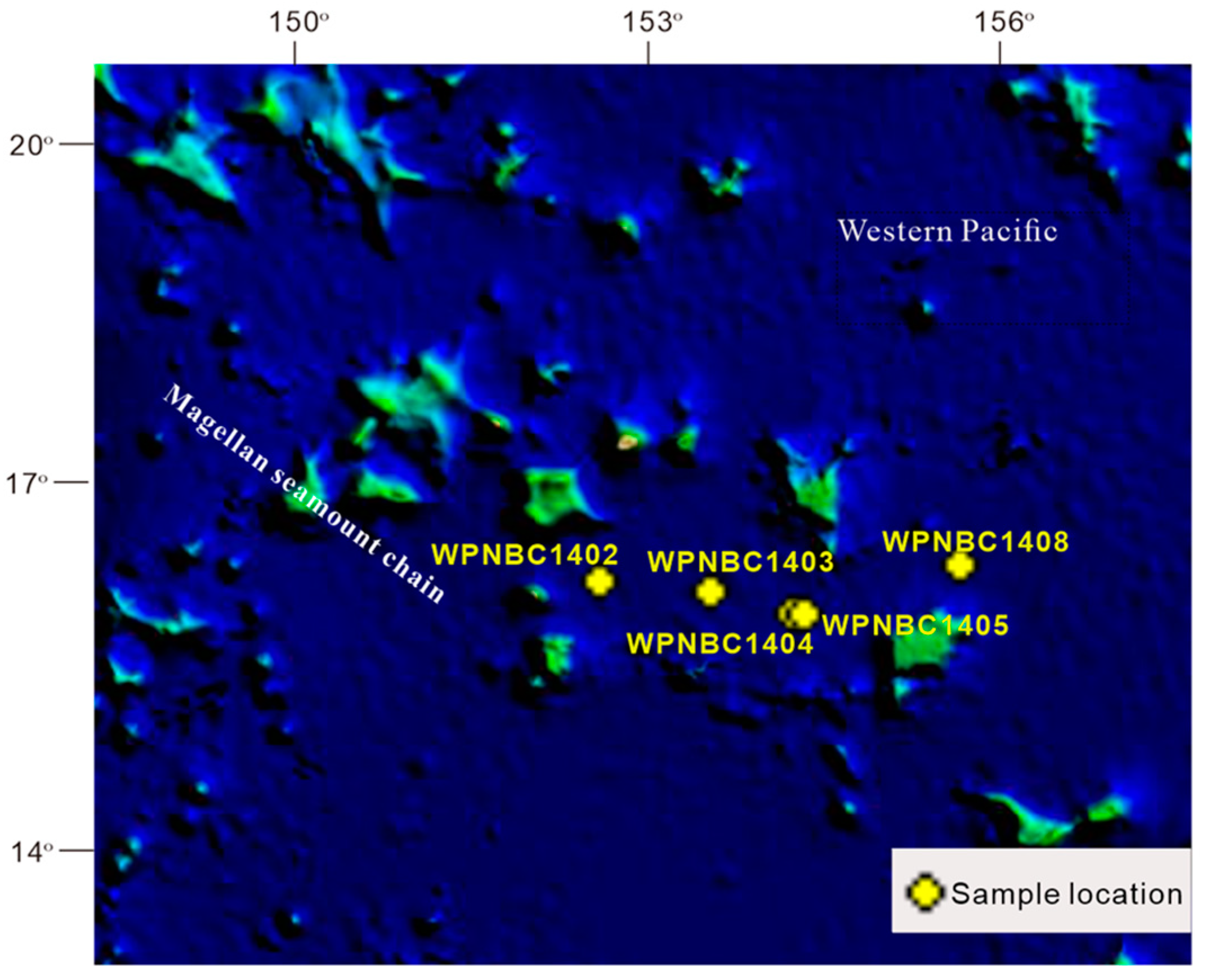
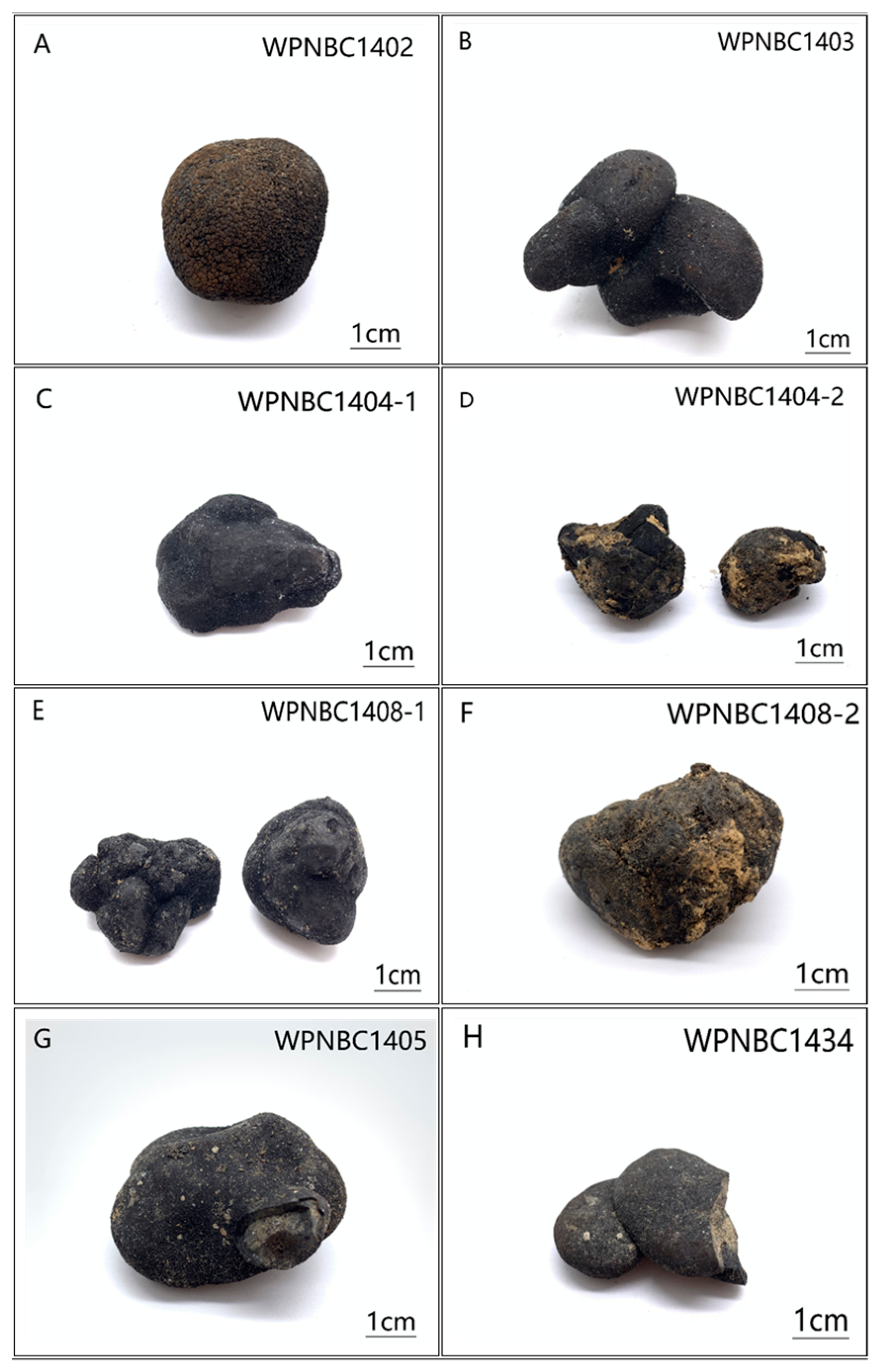

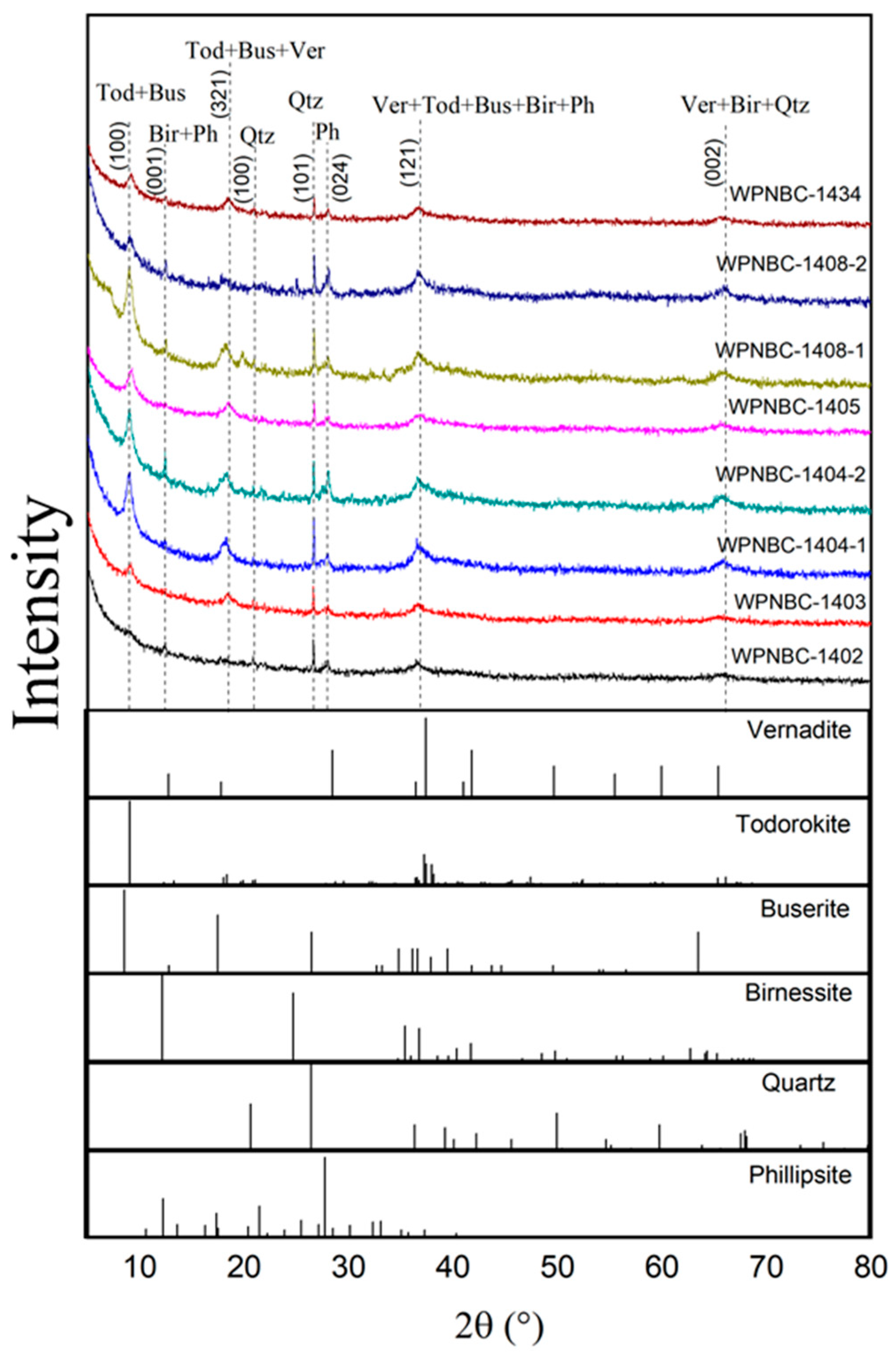
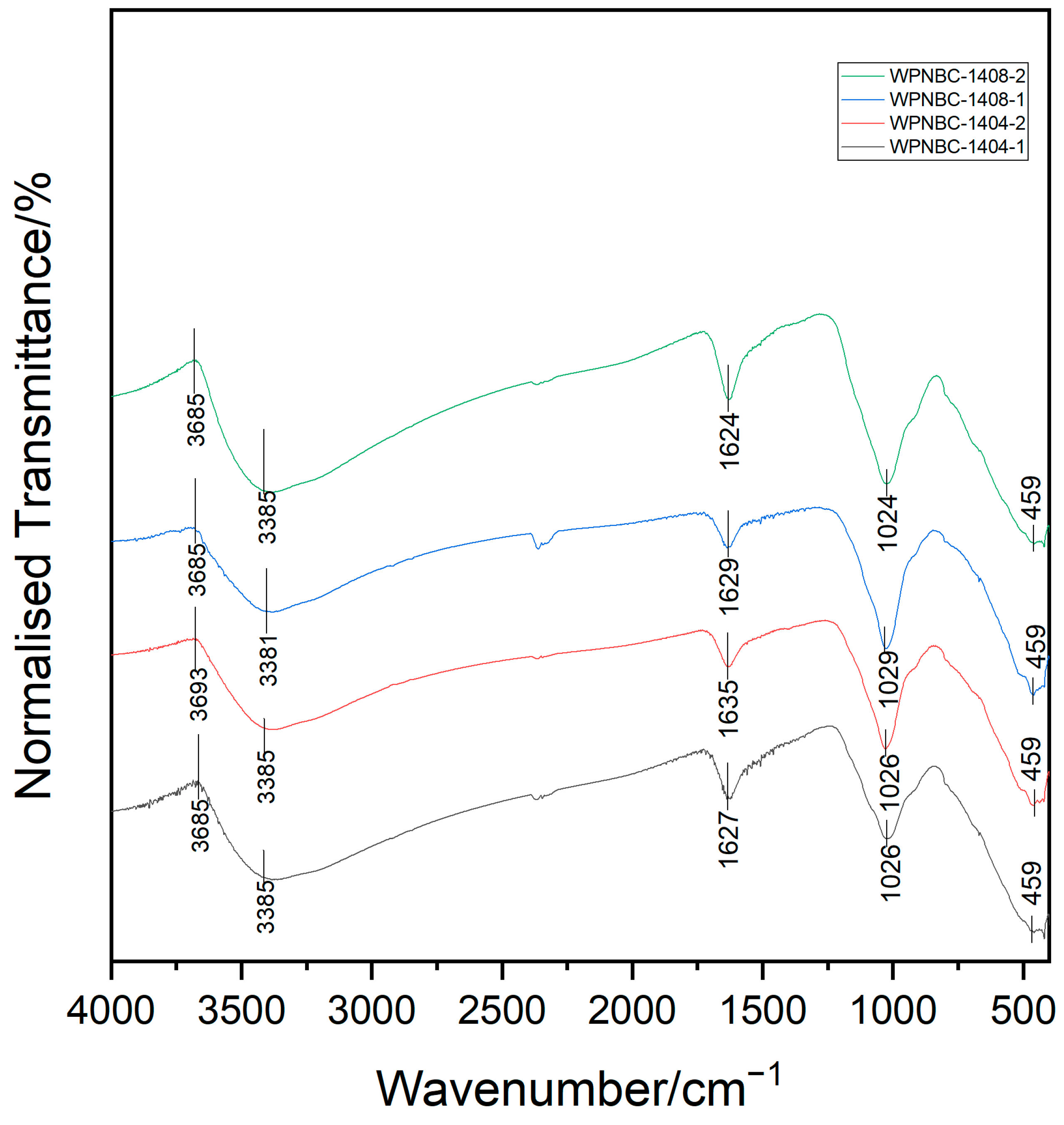
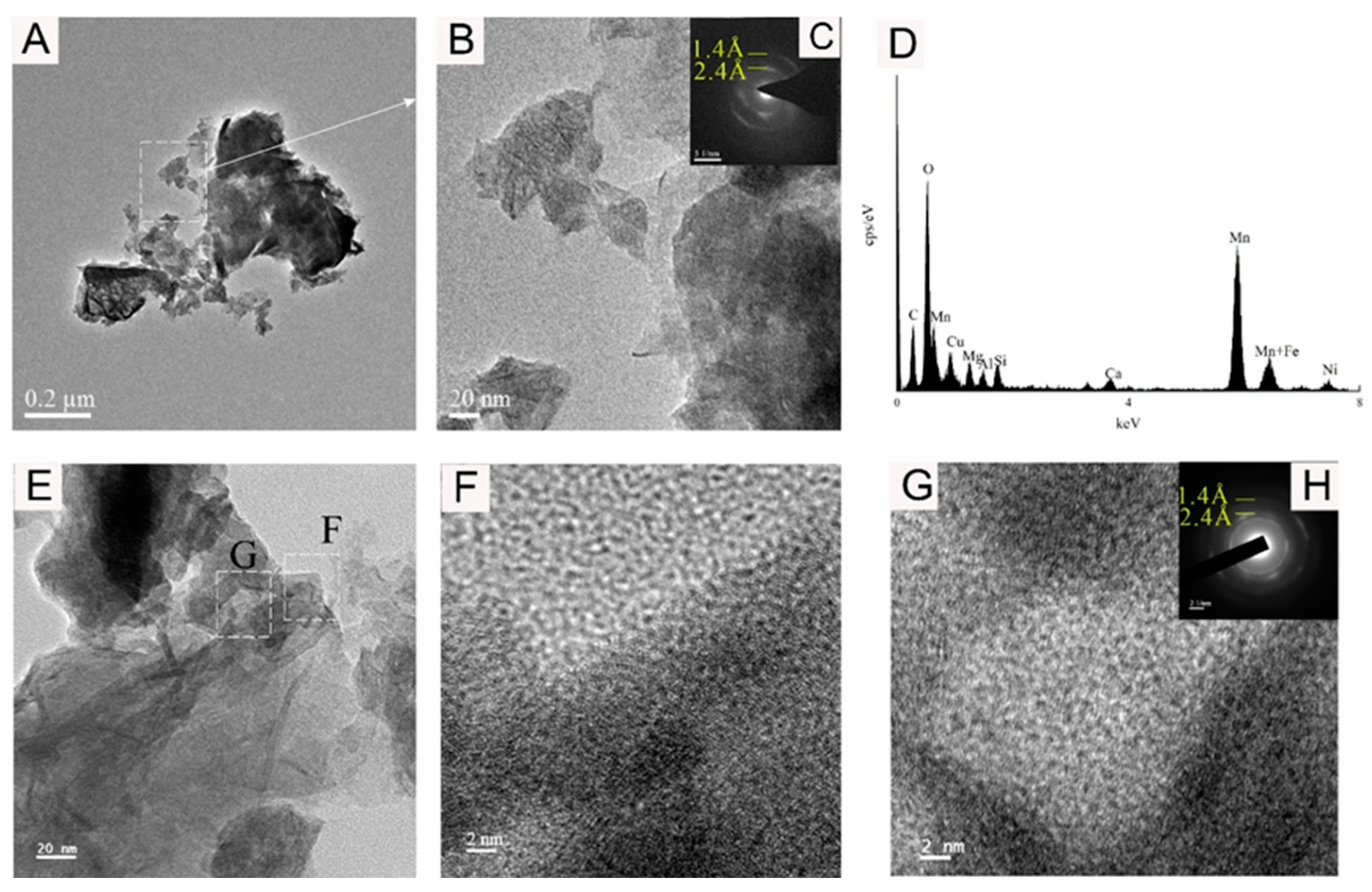

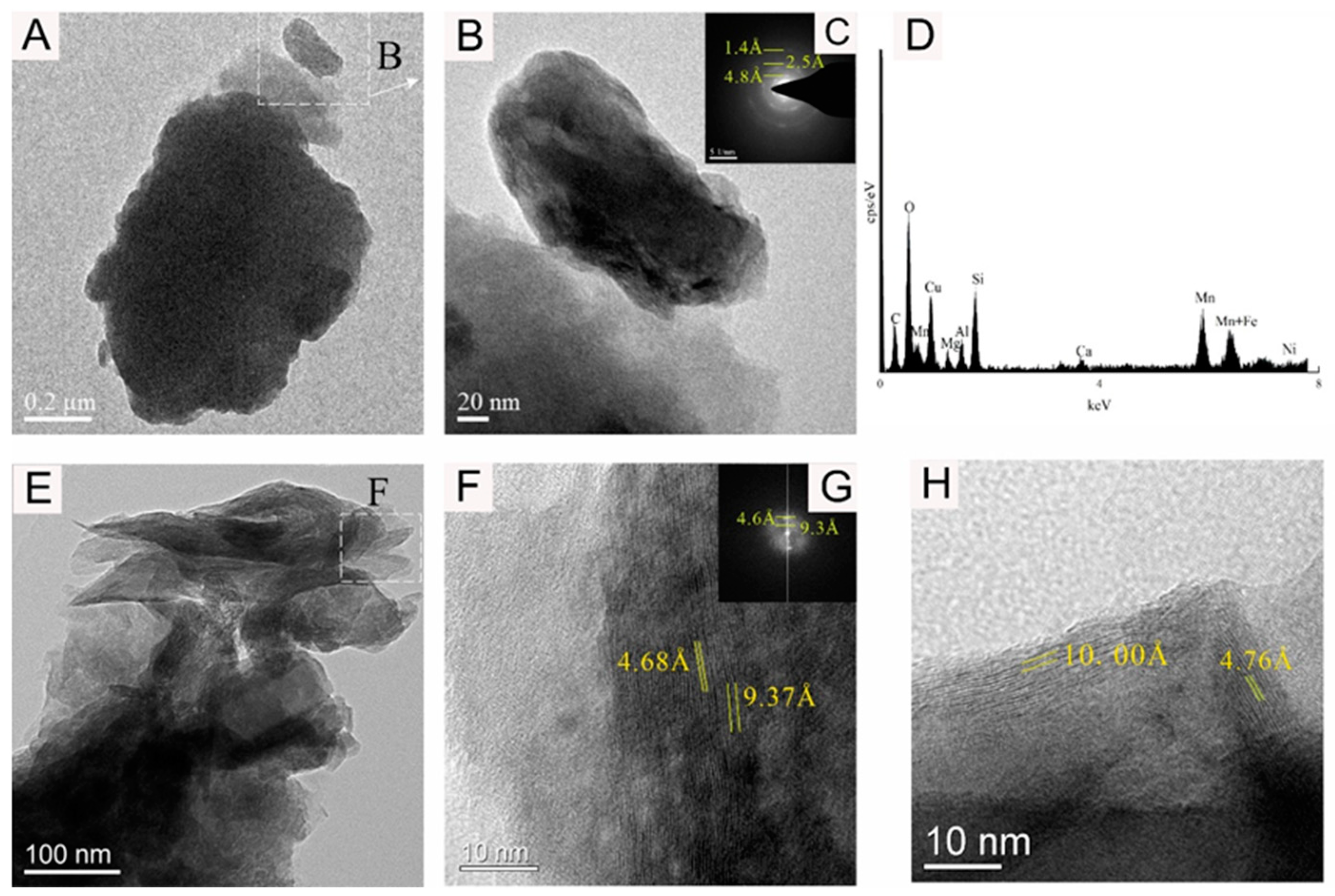
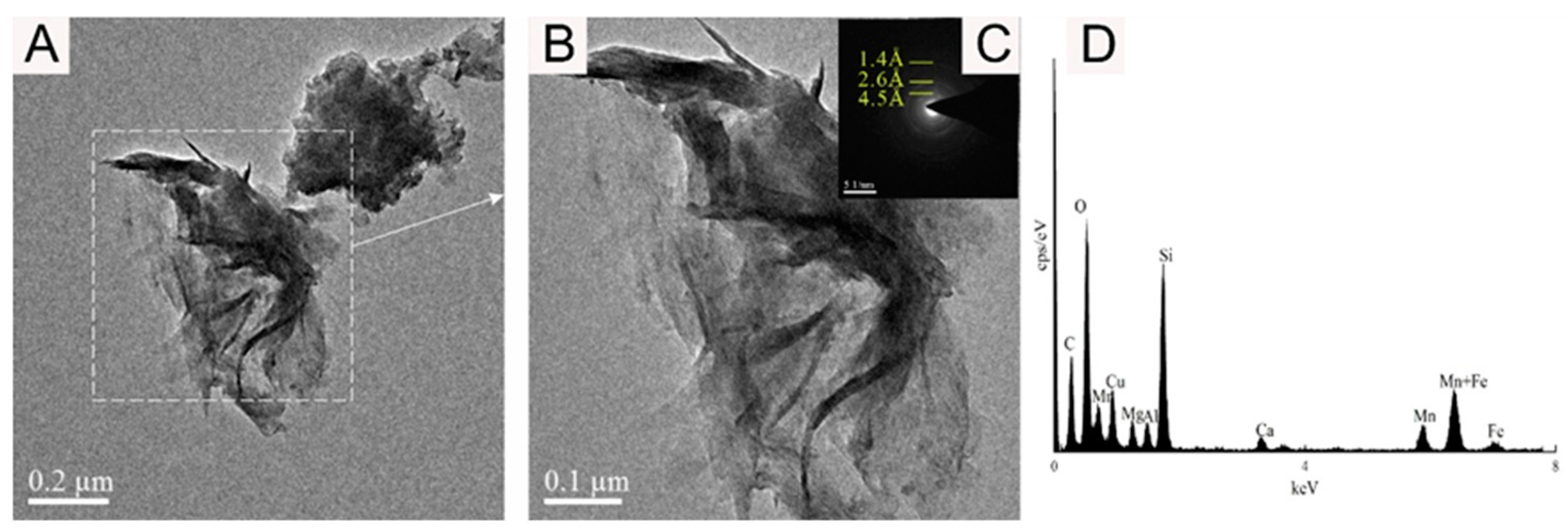
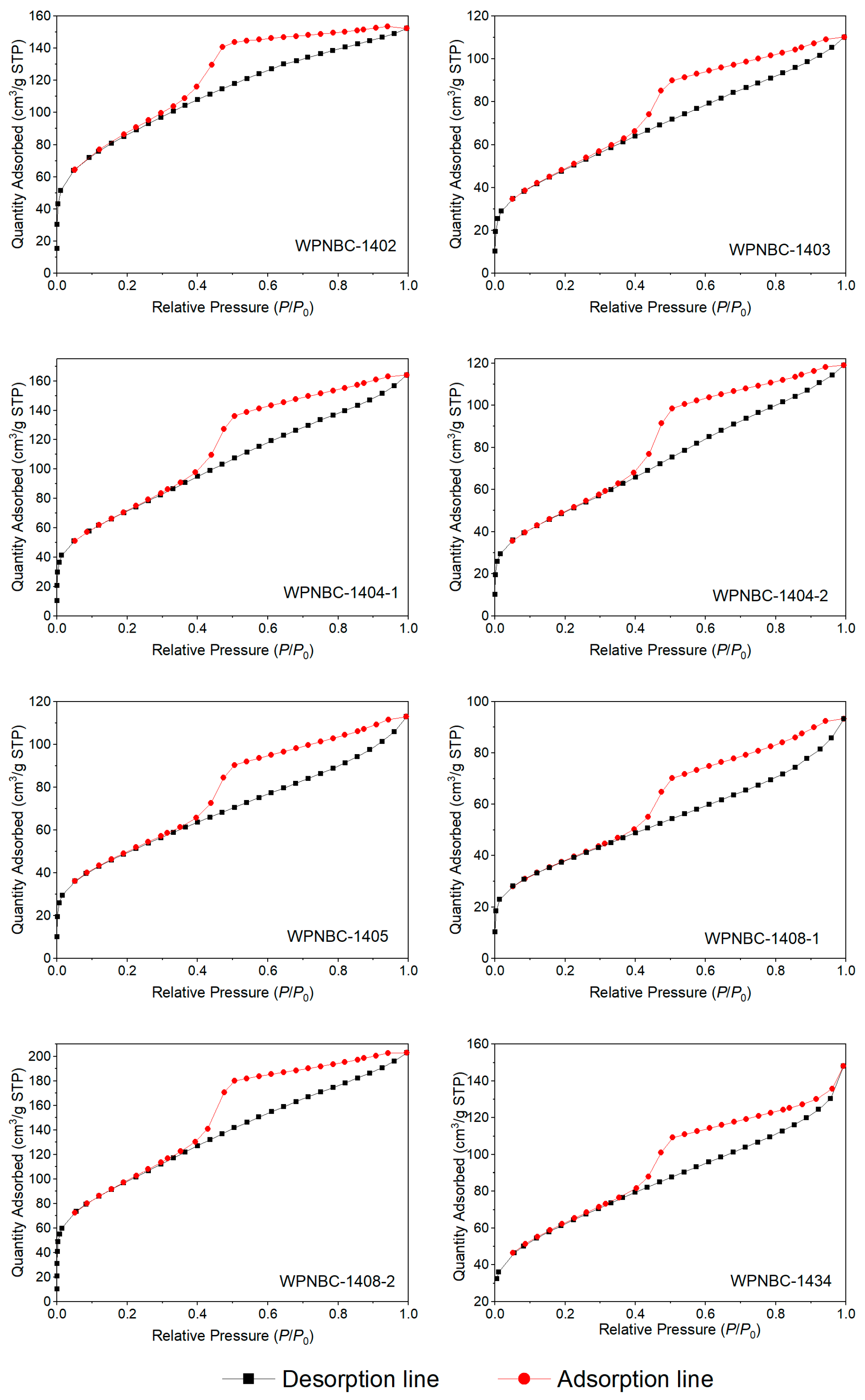



| Sample | Location | Type Symbol | Shape | Size (cm) | Color | Surface Structure | Mineral Composition |
|---|---|---|---|---|---|---|---|
| WPNBC1402 | 152.4643° E, 16.1576° N, 5842 m | S [S] | Spherical | 2.5 | Dark brown | Rough and flat | Tod, Ver, Bus Bir, Ph, Qtz |
| WPNBC1403 | 153.4024° E, 16.0701° N, 5718 m | M [IG] | Intergrowth | 4.5 | Dark brown | Smooth | Tod, Ver, Bus Bir, Ph, Qtz |
| WPNBC1404-1 | 154.0992° E, 15.8841° N, 5603 m | M [I] | Irregular | 3 | Dark brown | Smooth | Tod, Ver, Bus Bir, Ph, Qtz |
| WPNBC1404-2 | 154.0992° E, 15.8841° N, 5603 m | S [I] | Irregular | 2.5 | Dark brown | Rough, with yellowish brown sediment | Tod, Ver, Bus Bir, Ph, Qtz |
| WPNBC1405 | 154.1969° E, 15.8777° N, 5615 m | M [I] | Irregular | 3.9 | Dark brown | Rough, with yellowish brown sediment | Tod, Ver, Bus Bir, Ph, Qtz |
| WPNBC1408-1 | 155.5140° E, 16.2958° N, 5852 m | S [I] | Irregular | 2 | Dark brown | Smooth | Tod, Ver, Bus Bir, Ph, Qtz |
| WPNBC1408-2 | 155.5140° E, 16.2958° N, 5852 m | M [E] | Ellipsoid | 4.5 | Dark brown | Rough, with yellowish brown sediment | Tod, Ver, Bus Bir, Ph, Qtz |
| WPNBC1434 | - | M [IG] | Intergrowth | 3.5 | Dark brown | Smooth | Tod, Ver, Bus Bir, Ph, Qtz |
| Sample | BET Specific Surface Area (m2/g) | Mean Pore Size (nm) | Pore Volume (cm3/g) | Data Sources |
|---|---|---|---|---|
| WPNBC-1402 | 311.310 | 3.028 | 0.236 | This paper |
| WPNBC-1403 | 177.042 | 3.852 | 0.170 | This paper |
| WPNBC-1404-1 | 260.288 | 3.899 | 0.254 | This paper |
| WPNBC-1404-2 | 179.653 | 4.101 | 0.184 | This paper |
| WPNBC-1405 | 180.037 | 3.881 | 0.175 | This paper |
| WPNBC-1408-1 | 137.536 | 4.196 | 0.144 | This paper |
| WPNBC-1408-2 | 355.990 | 3.525 | 0.314 | This paper |
| WPNBC-1434 | 224.842 | 4.075 | 0.229 | This paper |
| Sample mean | 228.337 | 3.820 | 0.213 | This paper |
| Spherical nodules from South China Sea | 258.397 | - | - | Guan, 2016 [30] |
| Large-pore pseudo-boehmite | 201 | 8.7 | 0.44 | Su et al., 2012 [31] |
| Mesoporous–macroporous activated alumina | 215 | - | 1.31 | Zhang et al., 2012 [32] |
| Large-pore special pseudo-boehmite | 220 | - | 1.25 | Wang, 2020 [33] |
Disclaimer/Publisher’s Note: The statements, opinions and data contained in all publications are solely those of the individual author(s) and contributor(s) and not of MDPI and/or the editor(s). MDPI and/or the editor(s) disclaim responsibility for any injury to people or property resulting from any ideas, methods, instructions or products referred to in the content. |
© 2023 by the authors. Licensee MDPI, Basel, Switzerland. This article is an open access article distributed under the terms and conditions of the Creative Commons Attribution (CC BY) license (https://creativecommons.org/licenses/by/4.0/).
Share and Cite
Xu, L.; Deng, Y.; Guan, Y.; Sun, X.; Li, D.; He, W.; Ren, Y.; Xiao, Z. Nano-Mineralogy and Mineralization of the Polymetallic Nodules from the Interbasin of Seamounts, the Western Pacific Ocean. Minerals 2024, 14, 47. https://doi.org/10.3390/min14010047
Xu L, Deng Y, Guan Y, Sun X, Li D, He W, Ren Y, Xiao Z. Nano-Mineralogy and Mineralization of the Polymetallic Nodules from the Interbasin of Seamounts, the Western Pacific Ocean. Minerals. 2024; 14(1):47. https://doi.org/10.3390/min14010047
Chicago/Turabian StyleXu, Li, Yuqi Deng, Yao Guan, Xiaoming Sun, Dengfeng Li, Wentao He, Yingzhi Ren, and Zhenglian Xiao. 2024. "Nano-Mineralogy and Mineralization of the Polymetallic Nodules from the Interbasin of Seamounts, the Western Pacific Ocean" Minerals 14, no. 1: 47. https://doi.org/10.3390/min14010047
APA StyleXu, L., Deng, Y., Guan, Y., Sun, X., Li, D., He, W., Ren, Y., & Xiao, Z. (2024). Nano-Mineralogy and Mineralization of the Polymetallic Nodules from the Interbasin of Seamounts, the Western Pacific Ocean. Minerals, 14(1), 47. https://doi.org/10.3390/min14010047






